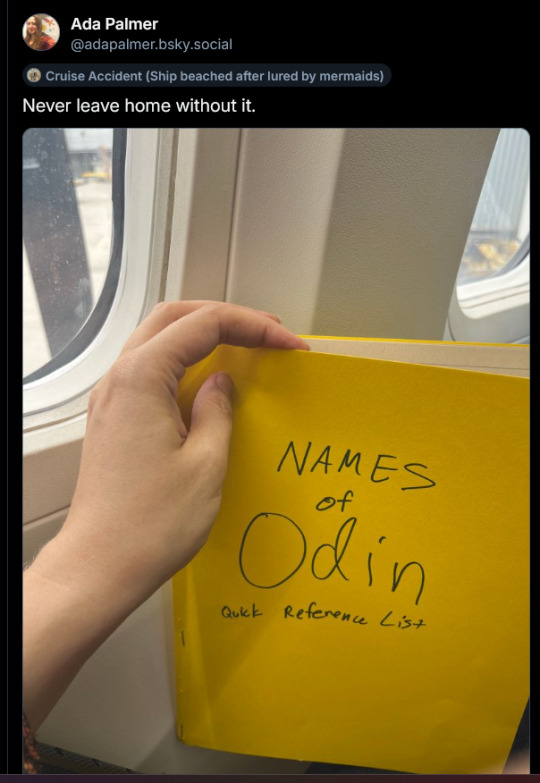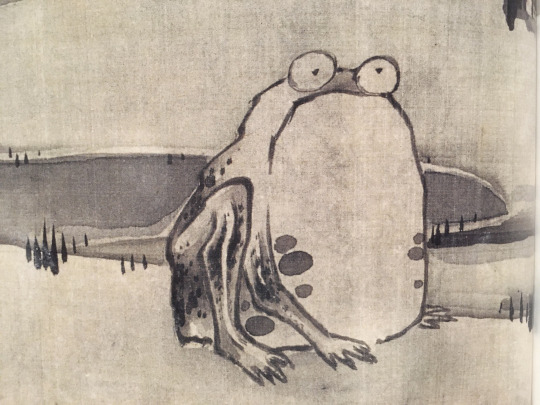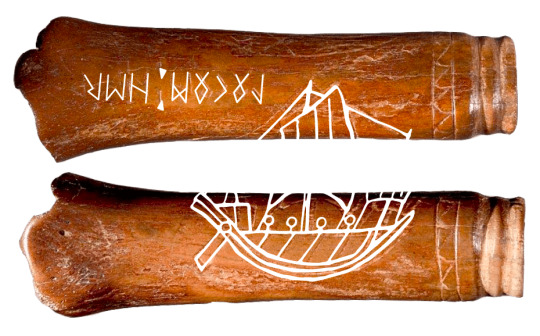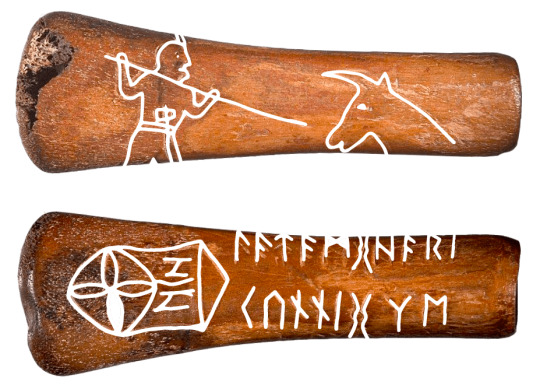Formerly GrimoireSideblog; Eira Olfrid Loptsjarsen. Inclusive Norse polytheist, Loki devotee, bioregional green witch and textile artist, vitki-trainee and aspiring pagan monastic. Internet old and mom friend. Queer as in identity is an ongoing lifelong process of shredding social constructs and shedding harmful normative behaviours. White supremacists and TERFs not welcome here.
Don't wanna be here? Send us removal request.
Text
i put everything you love inside a macguffin dude. all the heroes and villains are trying to find it dawg 😂 you're never getting it back
419 notes
·
View notes
Text
Happy winter solstice! The light begins to return tomorrow!!
118K notes
·
View notes
Text
Mischief

247 notes
·
View notes
Text
Watched a New Age lady ask her spirit guide to give her a message through ChatGPT, said message was identical to every other vague and insipid message New Age channelers put out there, and of course she and the lady she was streaming with acted like this was Oooooohhhh Deep Spiritual Wisdom.
#technopaganism is fine#but please do not confuse the energy-hungry unethically-created automated plagiarism machine#with anything that is spiritual or holy#it’s just a fucking next word prediction algorithm writ large#not to be a luddite but fuck the techbros pushing this slop down our throats and the credulous fools hyping it
90 notes
·
View notes
Text
Very interesting. This has been a question for a long, long time.
97 notes
·
View notes
Text

121 notes
·
View notes
Text
The reason Nazis, white supremacists, and other far-right groups have to resort to revisionism (often including the appropriation of pagan symbols, myths, and practices) to provide “historical support” for their ideals is because those ideals have no actual ancient counterparts. Fascism is a product of the modern era. There were no fascists in the ancient world, and there has never been a religion that genuinely supported fascist values.
For the most part, humans have always cared about each other. We have always had a strong sense of community, and we have always been willing to go out of our way to help other people. These are fundamental parts of human nature, and they are reflected in our religions. They are also, incidentally, totally incompatible with a fascist worldview, because fascism goes against human nature.
Fascists want you to believe that fascism is in your best interest. They want you to believe that the world is inherently cruel, that people have always been at each others’ throats, and that hatred is natural – because if you don’t believe these things, then fascism is of no use to you. They know that the easiest way to convince you to adopt fascist values is to infiltrate your religious community, to convince you that fascism is what the gods intend for us. To do that, they have to make you believe that your religion is inherently fascist – even though we know, based on copious written and archaeological evidence, that this is not true.
This is how we get Nazi revisions of Norse myths. This is how we get domestic terrorists storming government buildings while wearing Norse iconography. This is how we get the image in pop culture of the white, blond, blue-eyed, hyper-masculine Viking, a figure that did not exist in actual Old Norse society.
This isn’t just me talking out of my ass. This isn’t speculation. This is a documented tactic used by fascists to give their movements the appearance of legitimacy. Nazi Germany is largely responsible for our modern idea of the Vikings as a hyper-masculine, hyper-militant group of white dudes. Fascist Italy is a large part of why Ancient Rome is remembered for their military might rather than for their incredible infrastructure or their populist government. (Even the word “fascism” comes from an appropriation of Roman political symbols.) Irish American white nationalists are responsible for perpetuating the “Irish slave” myth (which is used to devalue the impact of the transatlantic slave trade and its effect on Black people), and for the popularity of Irish and Celtic symbols among modern fascists.
What all of these fascist revisionist histories have in common is that they are almost entirely baseless and have little-to-no connection to any genuine historic sources. There is no evidence for them beyond “because I say so” arguments from fascist authors. These histories are false, and their falsehood is very easily provable. The ONLY reason they are as widely accepted as they are is because fascist sources are very good at being louder and more aggressive than legitimate, objective historians.
If we want to reclaim paganism from fascists, the first step MUST be to set the historical record straight. Read good sources. Share resources with your community. Correct people who are unknowingly spreading fascist propaganda. Tell people who the ancient pagans really were, and what they really stood for.
Fascism is a weed. It is an invasive species that has forced its way into our religious spaces and is choking out the warm, loving communities the gods intended for us. Pull it up, burn the roots, salt the earth if you have to – if it is left unchecked, it will kill every other interpretation of our myths, until the truth is forever lost to the void.
#inclusive heathenry#nazi punks fuck off#pretty sure that one commenter thinks this post isn’t about them btw
388 notes
·
View notes
Text
Ukrainians holding their pride march in a subway because of russian bombs are immeasurably more powerful and real than any western tankie with a hammer-and-sickle or a Lenin profile on a trans flag.
3K notes
·
View notes
Text
Finding a colorblind friendly redesign of the rainbow flag has me happy to see a pride flag for once
54K notes
·
View notes
Photo

by artist Itō Jakuchu, 1790, Japan. Sano City Yoshizawa Memorial Museum
10K notes
·
View notes
Text


carved bones with runic inscriptions digitally outlined | c. 300 - 500 CE | weser river (modern day lower saxony, germany)
in the landesmuseum natur und mensch collection
635 notes
·
View notes
Text

My mom says i should put it on a T shirt lol
Design based on c11220 (unimus), a C type bracteate.
What i like especially about this particular C bracteate is 1: the little squirrel guy. 2: The big head biting the animals ear. 3: curly ear thing
28 notes
·
View notes
Text
Okay, so does anyone know how to back up your tumblr blog in a useful way? Ive already backed it up once (and still have that file), but its just like, one massive txt file that i cant really open because it just freezes my computer.
11 notes
·
View notes
Text
No spoilers, not a review of s2, just a nice summary of the show's influences that points to beats I don't think people always appreciate.
It’s not just that the supporting cast is overwhelmingly British and Irish; the themes and style are deeply influenced by shows including the classic drama Edge of Darkness (1985), The Sandbaggers (1978-80), and Harry’s Game (1982). Those were marked by an intense focus on political oppression, the costs and ironies of espionage, and the tense state of the nation. It is very easy to imagine Andor screening on ITV in the 1980s—with roughly 2 percent of the budget and a quarter of the episodes. British political drama was particularly shaped by both the Troubles in Northern Ireland and the 1984-85 miners’ strike. During the former, the violence was not confined to Belfast; the Irish Republican Army’s bombing campaign hit the British mainland repeatedly. There are still vanishingly few trash cans in British train stations, since they were removed for fear of explosives. Along with the violence came appalling miscarriages of justice by a police force that took an Irish accent as proof of guilt. During the miners’ strike, meanwhile, the British state employed policing tactics honed in Northern Ireland and Hong Kong at home. Clashes between miners and police turned into full-blown battles. Police spies went deep undercover within radical groups, including having relationships and children with activists. Both of these struggles inform Andor. The planet where the first season’s action starts and finishes, Ferrix, borrows its industrial culture from Britain’s mining towns—down to the role of a ceremonial colliery band. The uneasy occupation of Ferrix by imperial forces and street-level warnings of approaching troops are drawn from Belfast.
It was paywalled for me, so here'e the full piece:
The Empire has always been British. Ever since the first Star Wars, the villains have had stereotypically upper-class British accents. (Darth Vader is the chief exception; actor David Prowse’s rural West Country accent was overdubbed with the rich tones of James Earl Jones.) Yet many of the good guys have also been British—unsurprising for a franchise that from the start was principally filmed in the United Kingdom and drew much of its original inspiration from World War II movies depicting heroic British pilots and commandos.
But the Disney+ show Andor, which begins its second (and final) season on Tuesday, frames a galaxy far, far away in an entirely different form of Britishness: the leftist political dramas made during the Margaret Thatcher years.
Andor is a political thriller about living under a fascist state—one built on casual brutality, quota-driven slave labor, the destruction of minority culture, and the needs of endless war. It’s a vision of the Empire as a genuinely terrifying force, not as faceless drones with terrible aim. Death is frequent and not clean: Characters are hanged, electrocuted, crushed by sliding cargo, and stabbed in back alleys.
The series traces the political evolution of its eponymous main character, portrayed by Diego Luna, who first played the character in 2016’s Rogue One. In Rogue One, by largely the same creative team, Cassian Andor is an experienced rebel operative; in Andor, which starts five years earlier, he begins as an apolitical thief before being drawn into the nascent rebellion.
But the resistance here isn’t made up of the cleanly heroic fighter pilots of the Star Wars movies. It’s frayed, paranoid, and morally compromised, ready to sacrifice its own soldiers to avoid blowing a key intelligence source or to provoke the Empire into murdering civilians to drive the cause forward. In a critical monologue, the rebel organizer (played by Stellan Skarsgaard) spells out the cost of the struggle: “I’m condemned to use the tools of my enemy to defeat them. I burn my decency for someone else’s future. I burn my life to make a sunrise that I know I’ll never see.”
It is both incredible and mildly ridiculous that this show exists in the same universe as lightsabers and Ewoks. A peculiar thing happens with franchises as gigantic as Star Wars and its fellow member of the Disney entertainment juggernaut, the Marvel Cinematic Universe: The sheer number of movies and shows allows unexpected experimentation with genre and theme. Marvel’s Captain America: The Winter Soldier was a 1970s-style conspiracy thriller, Black Panther tackled Black militancy and Afrofuturism, WandaVision was a metafictional passage through U.S. sitcom history. Star Wars’ The Mandalorian is a science-fiction Western, while The Acolyte is a detective story.
Andor is largely the creation of American writer and director Tony Gilroy, who has been involved with several fine thriller movies, such as Michael Clayton and the Bourne franchise. But rather than just drawing on these thrillers, the new series traces its influences to the tense, political British TV series and movies of the 1970s to 1990s.
It’s not just that the supporting cast is overwhelmingly British and Irish; the themes and style are deeply influenced by shows including the classic drama Edge of Darkness (1985), The Sandbaggers (1978-80), and Harry’s Game (1982). Those were marked by an intense focus on political oppression, the costs and ironies of espionage, and the tense state of the nation. It is very easy to imagine Andor screening on ITV in the 1980s—with roughly 2 percent of the budget and a quarter of the episodes.
British political drama was particularly shaped by both the Troubles in Northern Ireland and the 1984-85 miners’ strike. During the former, the violence was not confined to Belfast; the Irish Republican Army’s bombing campaign hit the British mainland repeatedly. There are still vanishingly few trash cans in British train stations, since they were removed for fear of explosives. Along with the violence came appalling miscarriages of justice by a police force that took an Irish accent as proof of guilt.
During the miners’ strike, meanwhile, the British state employed policing tactics honed in Northern Ireland and Hong Kong at home. Clashes between miners and police turned into full-blown battles. Police spies went deep undercover within radical groups, including having relationships and children with activists.
Both of these struggles inform Andor. The planet where the first season’s action starts and finishes, Ferrix, borrows its industrial culture from Britain’s mining towns—down to the role of a ceremonial colliery band. The uneasy occupation of Ferrix by imperial forces and street-level warnings of approaching troops are drawn from Belfast.
A key moment of tension in Andor turns, as often in Northern Ireland, on a parade and a funeral. A long prison riot sequence is inspired in part by In the Name of the Father (1993), a film about the Guildford Four, who were wrongly convicted of pub bombings in the 1970s. In a scene evocative of anti-colonial violence from Belfast to Gaza, a boy mourning a murdered father builds a bomb whose throwing will spark a riot and massacre.
The U.K. is not, of course, the only influence. There is a strong Latin American subcurrent, from Andor’s childhood among an Indigenous-coded village destroyed by mining to the scenes of broken torture victims in improvised secret police cells. There are visible influences from resistance films including The Battle of Algiers and Army of Shadows.
The show’s structure is also a far cry from the quest narrative of the Star Wars movies. Multiple plot strands are wound together in the fashion of a state-of-the-nation novel; a series of three-episode arcs focused around Andor himself is mixed with ongoing threads of domination and resistance that span social classes. There are dozens of characters; even small roles have a richness and realism to them.
As Senator Mon Mothma, Genevieve O’Reilly transforms a background character first encountered in Return of the Jedi (one of just four women with speaking roles in the first movies) into a woman feeling the walls close around her as she poses as a political irritant but secretly funds militants. O’Reilly has played the character in numerous other Star Wars works, but this is the first time she has been given the opportunity to show off what she can really do as an actor. Mon Mothma’s husband is a recognizably upper-class London type in the mold of Boris Johnson, complaining that her liberal causes, unlike his “fun” imperial friends, make everything so “boring and sad.”
Like the dystopian film Brazil or Alan Moore’s original V for Vendetta comic series, Andor spends plenty of time inside the bureaucracy of fascism. The Empire is vicious and petty—and overstretched, guarding its slave labor facilities with too few soldiers, building its own doom with needless cruelty. In one of the show’s finest ironies, Andor is arrested and imprisoned not for the heist of an imperial armory he’s just committed but for being in the wrong place at the wrong time when a local cop is in a bad mood and the Empire needs prison camp labor to build its weapons.
The show humanizes imperial agents, from rent-a-cops and prison guards to secret police, without forgiving them. It begins with the killing of two corporate enforcers, petty bullies trying to run a shakedown on Andor himself. In a regular adventure drama, their deaths would be a way to show the coolness of the action hero; here, one dies accidentally, and the other pleads desperately for his life before the protagonist shoots him in desperation.
When we first meet Denise Gough’s secret police officer, to take another example, she’s a clever and determined woman struggling with uncooperative colleagues and institutional sexism. But as we see, she’s also a sadistic torturer, and even her earlier achievements are recast when we come to realize what “exceeding quota” in her sector actually means.
The other chief imperial viewpoint character is Syril Karn, played by one of the rare American actors in the show, Kyle Soller, and a creation of genius. He is a go-getter deputy police inspector in a self-tailored uniform surrounded by colleagues who just want to eat noodles and finish their shifts; his storyline is simultaneously hilarious, pathetic, and menacing.
I don’t know what will happen in the second season of this incredible show, which is dropping in three-episode blocks over four weeks. The creators may not have expected a story of lawless fascism to be quite so relevant to a U.S. audience. We know the end of this story, both for the character of Andor and for the ultimate victory of the resistance. But we don’t know the costs paid on the way.
10 notes
·
View notes
Text
Cynical brain tells me that what's going to happen is that Mark Carney's Liberals will win a majority government and then Trump will try to make some kind of move on Alberta and Saskatchewan, probably with the collaboration of local conservatives. It seems to be the Putin playbook.
#i hate that i've started thinking like this#< prev tags#you and me both OP#what a time to be alive#canadian politics#elbows up eh
35 notes
·
View notes


